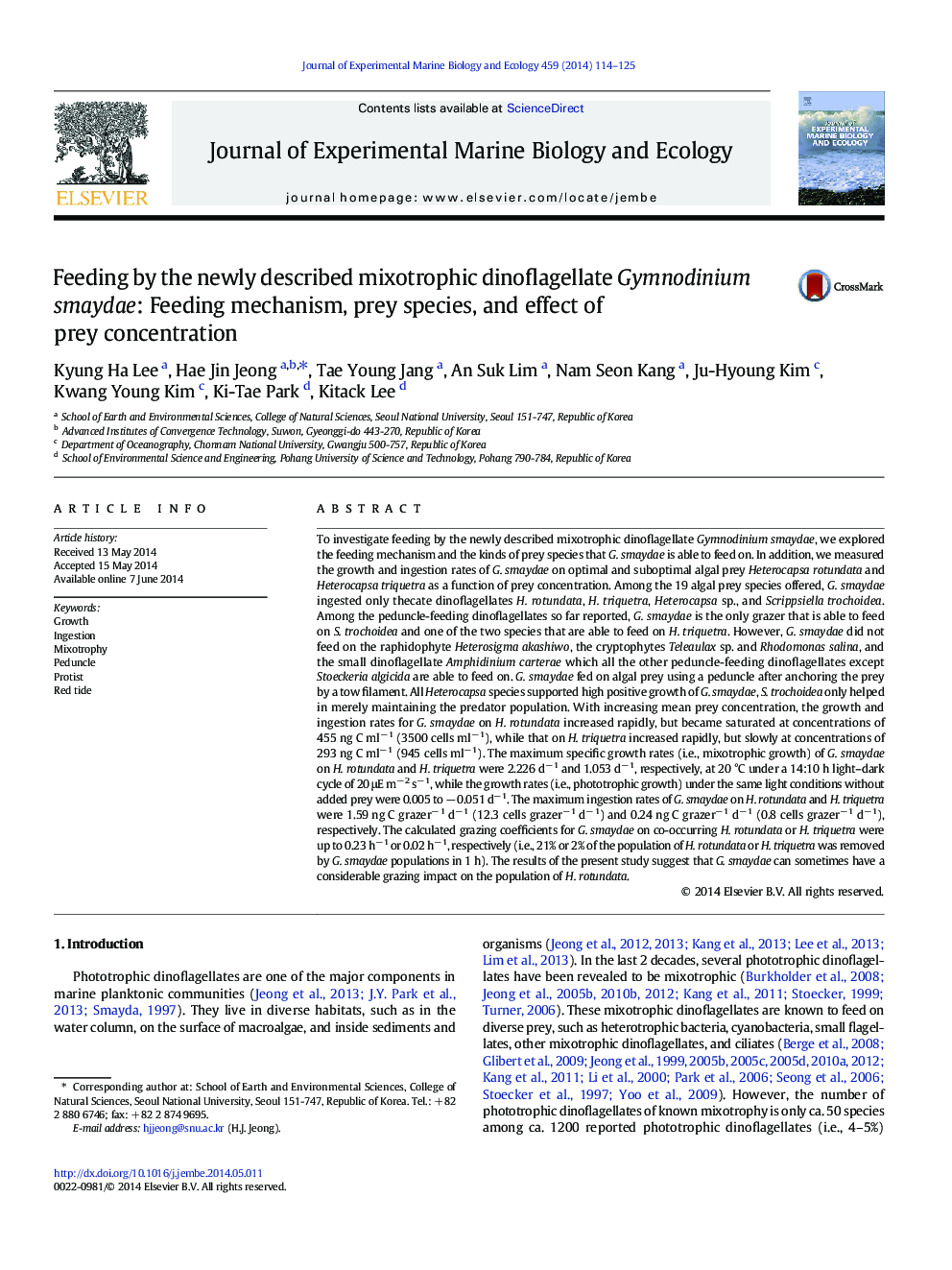| کد مقاله | کد نشریه | سال انتشار | مقاله انگلیسی | نسخه تمام متن |
|---|---|---|---|---|
| 6304111 | 1618416 | 2014 | 12 صفحه PDF | دانلود رایگان |

- Feeding by the dinoflagellate Gymnodinium smaydae was explored.
- G. smaydae ingested only Heterocapsa spp. and Scrippsiella trochoidea.
- All Heterocapsa spp. supported positive growth, but S. trochoidea did not.
- The maximum growth rate of G. smaydae on H. rotundata was 2.23 dâ1.
- G. smaydae sometimes have a considerable grazing impact on H. rotundata populations.
To investigate feeding by the newly described mixotrophic dinoflagellate Gymnodinium smaydae, we explored the feeding mechanism and the kinds of prey species that G. smaydae is able to feed on. In addition, we measured the growth and ingestion rates of G. smaydae on optimal and suboptimal algal prey Heterocapsa rotundata and Heterocapsa triquetra as a function of prey concentration. Among the 19 algal prey species offered, G. smaydae ingested only thecate dinoflagellates H. rotundata, H. triquetra, Heterocapsa sp., and Scrippsiella trochoidea. Among the peduncle-feeding dinoflagellates so far reported, G. smaydae is the only grazer that is able to feed on S. trochoidea and one of the two species that are able to feed on H. triquetra. However, G. smaydae did not feed on the raphidophyte Heterosigma akashiwo, the cryptophytes Teleaulax sp. and Rhodomonas salina, and the small dinoflagellate Amphidinium carterae which all the other peduncle-feeding dinoflagellates except Stoeckeria algicida are able to feed on. G. smaydae fed on algal prey using a peduncle after anchoring the prey by a tow filament. All Heterocapsa species supported high positive growth of G. smaydae, S. trochoidea only helped in merely maintaining the predator population. With increasing mean prey concentration, the growth and ingestion rates for G. smaydae on H. rotundata increased rapidly, but became saturated at concentrations of 455 ng C mlâ 1 (3500 cells mlâ 1), while that on H. triquetra increased rapidly, but slowly at concentrations of 293 ng C mlâ 1 (945 cells mlâ 1). The maximum specific growth rates (i.e., mixotrophic growth) of G. smaydae on H. rotundata and H. triquetra were 2.226 dâ 1 and 1.053 dâ 1, respectively, at 20 °C under a 14:10 h light-dark cycle of 20 μE mâ 2 sâ 1, while the growth rates (i.e., phototrophic growth) under the same light conditions without added prey were 0.005 to â 0.051 dâ 1. The maximum ingestion rates of G. smaydae on H. rotundata and H. triquetra were 1.59 ng C grazerâ 1 dâ 1 (12.3 cells grazerâ 1 dâ 1) and 0.24 ng C grazerâ 1 dâ 1 (0.8 cells grazerâ 1 dâ 1), respectively. The calculated grazing coefficients for G. smaydae on co-occurring H. rotundata or H. triquetra were up to 0.23 hâ 1 or 0.02 hâ 1, respectively (i.e., 21% or 2% of the population of H. rotundata or H. triquetra was removed by G. smaydae populations in 1 h). The results of the present study suggest that G. smaydae can sometimes have a considerable grazing impact on the population of H. rotundata.
Journal: Journal of Experimental Marine Biology and Ecology - Volume 459, October 2014, Pages 114-125